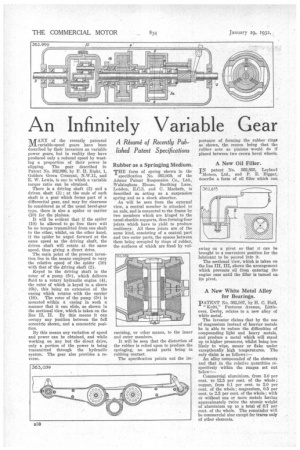An Infinitely Variable Gear
Page 68

If you've noticed an error in this article please click here to report it so we can fix it.
ANY of the recently patented variable-speed gears have been described by their inventors as variable power gears, but in reality they have produced only a reduced speed by wasting a proportion of their power in slipping. The gear described in Patent No. 362,999, by F. H. Right, 1, Golders Green Crescent, N.W.11, and E. W. Lewis, is one in which a variable torque ratio can be obtained.
There is a driving shaft (2) and a driven shaft (8) ; at the ends of each shaft is a gear which forms part of a differential gear, and may for clearness be considered as of the usual bevel-gear type, there is also a spider or carrier (10) for the pinions.
It will be evident that if the spider (10) be allowed to go free there will be no torque transmitted from one shaft to the other, whilst, on the other hand, if the spider be urged forward at the same speed as the driving shaft, the driven shaft will rotate at the same speed, thus giving a direct drive.
The main point of the present invention lies in the means employed to vary the relative speed of the spider (10) with that of the driving shaft (2).
Keyed to the driving shaft is the rotor of a pump (5s), which delivers fluid to a rotary hydraulic engine (4), the rotor of which is keyed to a sleeve (6b), this being an extension of the casing which rotates with the carrier (10), The rotor of the pump (5a) is mounted within a easing in such a manner that it can slide, as shown in the sectional view, which is taken on the line H, IL By this means it can occupy any position between the full eccentric shown, and a concentric position.
By this means any variation of speed and power can be obtained, and while working on any but the direct drive, only a portion of the power is being transmitted through the hydraulic system. The gear also provides a re erse.
Rubber as a Springing Medium.
THE form of spring shown in the
specification No. 363,039, of the Adams Patent Suspension Co., Ltd., Walsingbam House, Seething Lane, London, E.C.3, and C. Macbeth, is described as acting as a suspension spring and as a shock absorber.
As will be seen from the external view, a central member is attached to an axle, and is connected to the frame by two members which are hinged to the usual shackle supports, thus forming four joints which have to yield to produce resiliency. All these joints are of the same kind, consisting of a central part and two outer parts, the spaces between them being occupied by rings of rubber, the surfaces of which are fixed by vul
swing on a pivot so that it can be brought to a convenient position for the lubricant to be poured into it.
The sectional view, which is taken on the line III, III, .shows the arrangement which prevents oil from entering the engine case until the filler is turned on its pivot.
A New White Metal Alloy for Bearings.
PATENT No. 362,507, by H. C. Hall, " Kulti," Pastures Avenue, Littleover, Derby, relates to a new ahoy of white metal.
The inventor claims that by the use of magnesium instead of heavier metals he is able to reduce the difficulties of compounding light and heavy metals, and produce a metal which will stand up to higher pressures, whilst being les,-.4 likely to wipe, smear or flake under exceptionally high temperatures. The only claim is as follows:—
An alloy compounded of the elements and that in the relative quantities respectively within the ranges set out below :— Commercial aluminium, from 3.0 per Cent, to 12.5 per cent. of the whole ; copper, from 0.1 per cent, to 2.0 per cent, of the whole; magnesium, 0.5 per cent. to 2.3 per cent, of the whole; with or without one or more metals having approximately twice the atomic weight of aluminium up to a total of 0.7 per cent, of the whole. The remainder will be commercial zinc except for traces only of other elements.




































































































